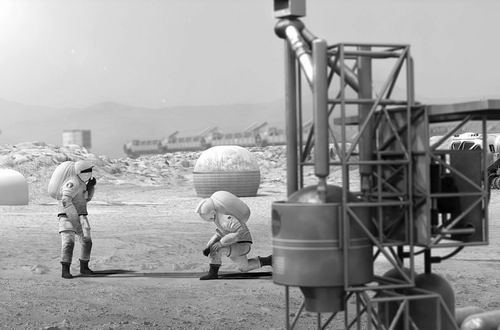Scientists find a new method of Mars oxygen -making
Author:Changjiang Daily Time:2022.08.18

The artist's concept of astronauts explore Mars. Picture source: NASA
Last year, NASA (NASA) realized the dream of science fiction writers for decades: creating oxygen on Mars. A device installed on the NASA "perseverance" detector can convert carbon dioxide into oxygen for 10 minutes. Now, physicists say they have conceived a way to use electronic beams in plasma reactors to produce more oxygen.
Michael Hecht, an experimental scientist at Massachusetts Institute of Technology, said that one day, this technology can not only help astronauts breathe on this red planet, but also use fuels and fertilizers. However, Hecht, who is responsible for oxygen -making equipment on the Mars cars, said that people still have many challenges to overcome by using new methods to take a car to reach our "neighbors".
After landing in the Jezuro meteorite pit in 2020, the "Perseverance" performed the MOXIE Experiment (Moxie). The experimental device was inhaled into Mars, of which 95%were carbon dioxide. By injecting the current between the two opposite electrodes of the electrochemical battery, Moxie can decompose carbon dioxide into carbon monoxide and oxygen ions. The final combination of oxygen ions produces oxygen.
In order to work, Moxie needs to pressure and heat Mars air, which requires additional parts to consume energy and lead to large volume.
Vasco Guerra, a physicist at the University of Lisbon University, believes that plasma reactors may be a better way. A bouquet of electrons is accelerated to a specific energy level, which can decompose carbon dioxide into its component ions, or plasma, just like Moxie.
In addition, the plasma reactor is very suitable for Mars atmosphere, because the latter is about 1/100 of the earth atmosphere. Guerra said it is much easier to make and accelerate electron beams in thin air.
In the laboratory, Guerra and colleagues will inject air into the metal tube with the air that matches Mars and components. Unlike Moxie, they do not need compression or heating air. However, by transmitting electron beams to the reaction room, they can convert about 30%of air into oxygen. The research team reported on August 16th in the "Physics Magazine" that they estimate that this device can produce about 14 grams of oxygen per hour, which is enough to support 28 minutes of breathing.
Hecht pointed out that the Guerra team still needs to solve some practical problems. He said that if you want to work on Mars, plasma equipment requires a portable power supply and a place where oxygen is stored. All of them may make it look not as bulky as the Moxie device. Hecht said that if the space agency is willing to spend millions of US dollars to develop plasma reactors, just like NASA developed Moxie, this method will mature. "There is no problem with plasma technology, but it is not as mature as Moxie technology," he said.
Related thesis information:
https://doi.org/10.1063/5.0098011
In
(Source: Journal of Science)
【Edit: Wang Yujin】
For more exciting content, please download the "Da Wuhan" client in the major application markets.
- END -
In the 10th anniversary of ISC, digital security ushered in the "Cambrian Breaking out"

@新 新 新Author 丨 Bai YanEdit 丨 MonthlyIn 1991, the U.S. government issued a dig...
Tesla and Huawei use software to redefine cars?

The picture comes from Canva.Software will account for 90%of the future car innova...